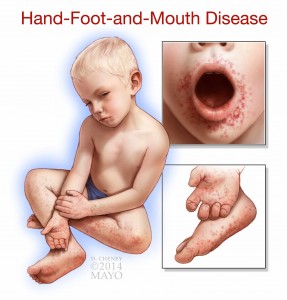DEAR MAYO CLINIC: What are the best ways to treat a toddler who has hand-foot-and-mouth disease? Does she need to be seen by a doctor? Does having it once mean she will not get it again?
ANSWER: Hand-foot-and-mouth disease is caused by a virus. It usually leads to mild illness and discomfort that does not require any specific treatment. You should contact your doctor, however, if your child’s symptoms are persistent or if her symptoms get worse. Although they do build up immunity to it over time, children can get hand-foot-and-mouth disease more than once.
Hand-foot-and-mouth disease is common in young children, most often in kids younger than 5. Children who go to child care centers are at higher risk for the condition than others because hand-foot-and-mouth disease spreads by person-to-person contact.
Hand-food-and-mouth disease is most often caused by a coxsackievirus. A fever is usually the first sign of the illness. Other symptoms appear within a few days. They include a sore throat and blisters or sores on the tongue, gums, back of the throat and inside of the cheeks. Blister-like lesions that are red to gray-white usually appear on the palms of the hands and soles of the feet. In some cases, a red rash also may develop on the thighs, buttocks and groin. Children affected by this disorder may have a general feeling of illness and lose their appetite.
Because it is a viral infection, no treatment is needed. Hand-foot-and-mouth disease typically goes away on its own in seven to 10 days. The mouth sores may be painful, though, and a topical oral anesthetic can help provide relief. The medication comes in gels and creams, and you can buy it without a prescription. Pain medication such as acetaminophen or ibuprofen also can help ease discomfort. Children should not take aspirin because it has been linked to a rare but serious condition called Reye’s syndrome.
To help soothe her mouth and throat, encourage your daughter to eat cool foods and beverages, such as ice cream, sherbet, ice pops, milk and ice water. Offer her soft, smooth foods that will not irritate her mouth and throat. Rinsing her mouth with warm water after she eats can help, too. Avoid foods that could make mouth sores worse. These include spicy and salty foods, as well as acidic foods and beverages, such as citrus fruit, soda and fruit juice.
Self-care at home is usually all that is required to manage hand-foot-and-mouth disease until the symptoms disappear. But contact your child’s doctor if mouth sores or a sore throat make it hard for her to drink fluids. Seek medical care if any of the symptoms are severe, if they get worse over time, or if they last longer than 10 days .
.
Hand-foot-and-mouth disease is highly contagious. It can be hard to prevent because children who have it can spread it to others before symptoms appear. You can help lower your child’s risk by teaching her good hygiene habits, such as frequent and careful hand washing. Also, gently encourage her not to put her fingers, hands or any objects in her mouth.
Because it is so contagious, a child may get hand-foot-and-mouth disease more than once, especially if it is being spread among a group of children in a child care or school setting. As they get older and are exposed to the virus several times, children tend to build up antibodies against it. This makes it less likely for teenagers and adults to get hand-foot-and-mouth disease. — Megha Tollefson, M.D., Pediatric Dermatology, Mayo Clinic, Rochester, Minn.







